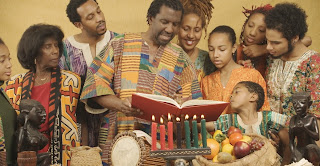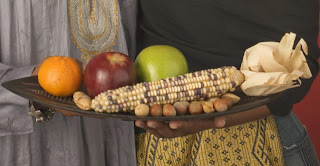http://cdn.history.com/sites/2/2013/12/kwanzaa-P.jpeg
Dr. Maulana Karenga
http://cdn.history.com/sites/2/2013/12/maulana-karenga-P.jpeg
The
candle-lighting ceremony each night gives the opportunity to get together and
talk about the significance of Kwanzaa. One
candle is lit each evening and the appropriate principle is discussed. The seven principles are: unity, self-determination,
collective work and responsibility, cooperative economics, purpose, creativity,
and faith. Three of the seven candles
are red, representing African struggle; three of the candles are green, representing
the land and hope for the future; and one candle is black, representing African
ancestry. Several families who celebrate
Kwanzaa dress up or adorn their homes in those colors.
http://cdn.history.com/sites/2/2013/12/kwanzaa-seven-symbols-P.jpeg
The
seven symbols are: crops (fruits, nuts, and vegetables – represents work and
the meaning of the holiday), place mat (made from straw or cloth, comes from
Africa and represents history, culture, and tradition), ear of corn (represents
fertility and the future hopes of a family), the seven candles (ceremonial objects
that represent symbolically the sun’s power and to provide light), the candleholder
(the “kinara” is the center of the Kwanzaa setting and represents our
ancestry), the unity cup (a special cup that is used to do the libation ritual
during the Karamu feast on the sixth day of Kwanzaa. In many African societies
libation are poured for the living dead whose souls stay with the earth), and gifts
(on the seventh day of Kwanzaa, meaningful gifts are given to inspire growth,
self-determination, and success). Gifts
given to family members on the last day of Kwanzaa are often homemade. Some families buy books, music, art accessories
or other culturally-themed gifts, preferably from a family-owned store.
http://cdn.history.com/sites/2/2013/12/kwanzaa-fruits-nuts-P.jpeg
http://cdn.history.com/sites/2/2013/12/kwanzaa-gifts-P.jpeg
For
more information, visit: http://www.history.com/topics/holidays/kwanzaa-history/videos.
Thank
you for reading my Holiday and Related Foods Blog! Unfortunately, this will be my last blog for
a while. Have a great summer!
Work
Cited
History
Channel Staff. Kwanzaa. The History Channel. (2009). A&E Television
Networks. Retrieved May 11, 2015.
















